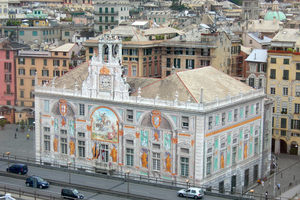Palazzo San Giorgio in Genova, Italy

Palazzo San Giorgio or the Palace of Saint George, may not be among Genoa’s top tourist attractions, but its historic significance is more than worth noting. Not only is it the site where Marco Polo’s famous memoirs were written, but it also once housed one of the oldest banks in history.
Originally constructed in 1260 by Guglielmo Boccanegra, uncle of the first Doge of Genoa, the Palazzo San Giorgio was intended to create a center of civil power in contrast to the religious power held by the Cathedral of San Lorenzo. Its role as the municipal seat did not last long however, as Boccanegra was forced into exile in France in 1262.
The palace became a prison shortly after where Polo was confined after the Genoese captured him during the Battle of Curzola in 1298. He orally related his adventures in the east to a fellow prisoner, Rustichello da Pisa, who later published the stories as Il Milione, or The Travels of Marco Polo.
Genoa’s war with Venice escalated the city’s public debt during the 14th-century. To consolidate it, the Bank of Saint George was established in 1407, making it one of the oldest chartered banks in European history. It placed its headquarters at the Palazzo San Giorgio and remained active until the fall of the Republic of Genoa in 1797. The bank officly went defunct in 1805.
Although it faced demolition during the 1830s, the palace remained thanks in part to the protests from Genoa’s citizens and intellectuals. It underwent numerous restorations since the late 19th-century and still stands tall and proud today. Its Renaissance-style façade is decorated with beautiful frescoes.





